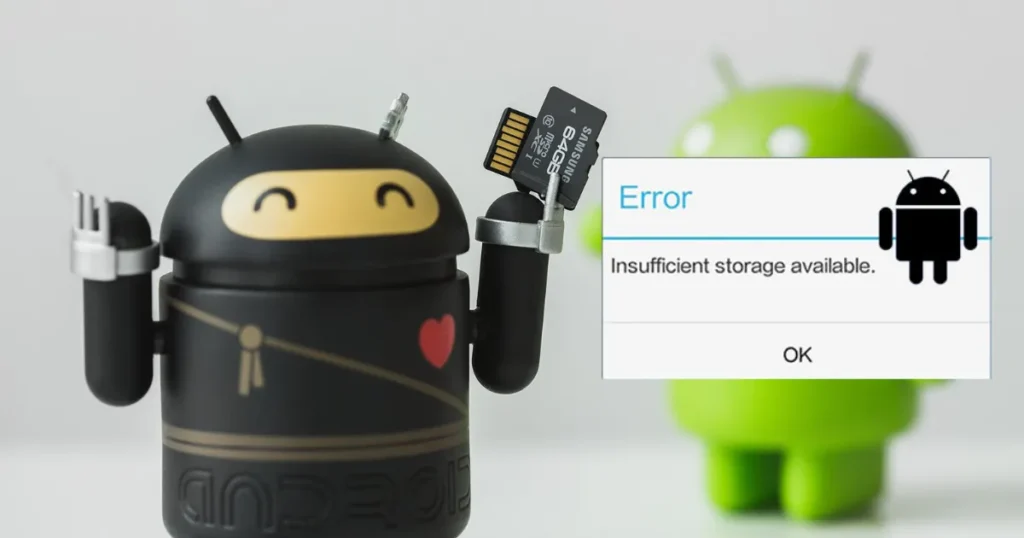How to Solve Insufficient storage available error on Android
Description

What does it mean when it says “Insufficient Storage Available” on your Android device?
This error often surfaces when the device’s memory is brimming over, leaving users puzzled by the lack of working space despite having deleted files or apps. Android insufficient storage space can be a perplexing issue, attributed to the apps, their data files, and especially their cache – which, although reported as free space by Android, can grow sizeable enough to cause confusion and frustration.
Addressing the “Insufficient Storage Available” error doesn’t have to be daunting. By exploring the underlying causes, such as incorrect partitioning or corrupted app data, and using targeted solutions like clearing app cache or managing unnecessary files, we can navigate towards an efficient fix.
This article promises to arm you with ways to tackle insufficient storage available Play Store issues, decipher why your phone says insufficient storage but I have space, and offer strategies for freeing up that much-needed space for your Android device.
Table of Contents
Understanding Storage Space on Android
What Causes “Insufficient Storage Available” on Android?
Have you ever wondered why, despite having space on your device, you encounter the “insufficient storage available” error on your Android phone? This frustrating situation often stems from how Android manages its storage.
The operating system itself consumes a significant portion of the internal storage, especially on budget devices with limited capacity. This becomes problematic when updating or installing new apps, as the system requires free space beyond the app’s size for temporary files and updates.
How to Solve Insufficient storage available error on Android
To tackle this issue, start by checking the “Storage” section in your Android’s Settings app.
Here, you’ll find a detailed breakdown of what’s consuming your storage. Android divides storage into categories such as app memory, system memory, and user data.
Often, the internal storage is full due to accumulated cache, large app data, and media files, even if an external SD card has space available. Regularly clearing the app cache, uninstalling unused apps, and managing media files can help free up space.
Additionally, tools like Google’s Files app can assist in cleaning up residual files and recommending files for deletion.
Promised Strategies for Managing Android Storage
We understand the challenges of managing storage on Android devices and promise effective strategies to help you regain control. By regularly monitoring your storage usage through the settings and employing tools to optimize space, you can significantly improve your device’s performance.
Adopting habits like storing media on cloud services and using features like Google Photos’ Smart Storage can automatically manage space by removing backed-up photos, ensuring your device remains clutter-free.

01. Clearing App Cache to Free Up Space
Why Do You Encounter “Insufficient Storage Available”?
Often, the “insufficient storage available” error on your Android device is linked to the cache that accumulates as you use various apps and browse the internet. This cache, although meant to speed up app performance by storing temporary data, can fill up your device’s storage if not managed properly.
Steps to Clear Your App Cache
- Open Settings on Your Android Device: Navigate to the settings menu to begin the cache clearing process.
- Access Battery and Device Care: Find and tap on the ‘Battery and device care’ option.
- Go to Memory and Review Apps: Select ‘Memory’ followed by ‘Apps not used recently’ to see a list of applications that you haven’t used lately.
- Choose an App to Clean Up: Tap on an app from the list to view more details.
- Select Storage in App Info: After selecting an app, go to the ‘Storage’ section within the app’s information page.
- Clear Cache: Tap on ‘Clear cache’ at the bottom of the screen to remove temporary files.
- Repeat for Other Apps: Follow the same steps for each app whose cache you wish to clear.
Promising Solutions for Managing Storage
By regularly clearing the app cache, you can prevent storage from being overwhelmed by unnecessary data, ensuring your device operates more efficiently. Apps like AVG Cleaner can automate this process, making it easier to maintain optimal performance.
For a more thorough cleanup, consider wiping the app data, which deletes all user data stored within an app, returning it to its original state. This can be particularly effective if apps are not functioning correctly or if your device is slow.
Managing Apps and Unnecessary Files
How Can You Effectively Manage Apps and Unnecessary Files?
Are you wondering why your Android device still says “insufficient storage available” even after some cleanup? This common issue might be due to apps and files that are not actively managed.
Let’s explore how you can regain control of your device’s storage by effectively managing apps and unnecessary files.
Step-by-Step Guide to Freeing Up Storage
- Identify and Uninstall Unnecessary Apps:
- Open the Google Play Store app.
- Tap the Profile icon at the top right.
- Go to ‘Manage apps & devices’ then ‘Manage’.
- Review the apps sorted by least used and uninstall those that are not essential.
- Managing Large App Data:
- Check apps that store offline files or logs which consume considerable space.
- For apps with large data, clear their data or consider uninstalling and reinstalling them.
- Remove Miscellaneous and Corrupted Files:
- Use a file manager to explore and delete downloaded files, logs, and media that are no longer needed.
- Look for corrupted files that occupy space but are not usable and delete them.
- Handle Hidden Files:
- Some files in directories like Sdcard0 may not be visible initially.
- Utilize a file manager app to uncover and remove these hidden files.
Regular Maintenance Tips
- Automate Cleaning: Use apps like ‘Files by Google’ for regular cleaning. Here’s how:
- Open ‘Files by Google’.
- Navigate to ‘Clean’ tab from the menu.
- Follow prompts to remove junk files.
- Transfer Files to External Storage: Move large files or apps to an SD card if your device supports it to free up internal storage.
- Monitor and Manage Regularly: Keep a regular check on your storage space and clean unnecessary files and apps periodically to ensure your device runs smoothly.
By following these steps, you can effectively manage your Android device’s storage and resolve issues related to insufficient storage available.
02. Transferring Photos and Videos
Why Transfer Photos and Videos?
Are you constantly facing the “insufficient storage available” error on your Android device? A significant portion of storage is often consumed by photos and videos. Transferring these large files can dramatically free up space, allowing your device to perform better.
How to Use Google Photos for Space Management
- Install Google Photos:
- Download the Google Photos app from the Play Store and install it on your Android device.
- Backup Your Media:
- Open Google Photos and sign in with your Google Account.
- Ensure that all your photos and videos are backed up. You can check this under the ‘Photos’ tab.
- Free Up Device Space:
- Tap on your profile photo or initial, then select ‘Free up space’.
- The app will display how much space you can free up. Tap ‘Free up’ to remove the backed-up photos and videos from your device.
Additional Tips for Managing Photos and Videos
- Smart Storage: Activate the Smart Storage feature in Google Photos to automatically delete backed-up photos after 60 days or when the device storage is low.
- Transfer to External Storage: For non-cloud solutions, consider transferring photos and videos to an external SD card or connect your device to a computer and move the files manually.
- Manage Gallery Trash: Regularly empty the trash in your Gallery app to ensure deleted photos and videos aren’t consuming space.
- Disable Trash Settings: Adjust settings in your Gallery app to permanently delete photos instead of moving them to trash.
By implementing these strategies, we can effectively manage storage space and mitigate the challenges associated with insufficient storage on Android devices.
03. Utilizing Cloud Services for Storage Expansion
Why Consider Cloud Services for Storage Expansion?
Are you frequently encountering the “insufficient storage available” error on your Android device? One effective solution is to utilize cloud storage services, which offer a range of options to expand your storage capacity without the need for physical hardware upgrades.
Cloud Storage Solutions
- Google Drive: Ideal for Android users, Google Drive integrates seamlessly with Google accounts and offers 15GB for free. For more extensive storage needs, affordable plans start at $1.99/month for 100GB.
- OneDrive: Best for those embedded in the Microsoft ecosystem, providing 5GB for free with additional storage starting at $1.99/month for 100GB.
- Dropbox: Known for its user-friendly interface and robust file synchronization, Dropbox starts with 2GB free, with larger capacities available for a monthly fee.
- iCloud: Perfect for users of Apple devices, offering 5GB free with options to upgrade up to 2TB for a monthly fee.
Advanced Features of Cloud Services
- Smart Storage: Allows automatic deletion of backed-up photos and videos from devices when storage is below 25% or after 60 days.
- Streaming vs. Offline Access: Some services like Google Drive offer features that allow you to stream content directly from the cloud, saving on device storage.
- High-Security Options: Services like Sync.com and pCloud offer enhanced security features, making them ideal for sensitive data storage.
Cloud services not only provide a way to back up important data but also ensure that your device operates efficiently by keeping its storage unclogged.
By choosing the right service that aligns with your needs and budget, you can significantly alleviate the problems associated with insufficient storage on your Android device.
04. Performing a Factory Reset
What Happens When You Perform a Factory Reset?
Are you considering a factory reset to fix the “insufficient storage available” error on your Android device? A factory reset erases all data from your phone, returning it to its original state. This drastic measure is often used as a last resort when other space-clearing methods fail.
Steps to Perform a Factory Reset
- Backup Your Data: Before proceeding, ensure all important data is backed up to your Google Account or another secure location.
- Charge Your Device: Ensure your phone is charged to at least 70% or connected to a power source.
- Navigate to Settings:
- Tap on
Settings. - Scroll to
Systemand selectReset Options.
- Tap on
- Initiate the Reset:
- Select
Erase all data (factory reset). - Confirm by tapping
Reset phone.
- Select
- Enter Security Information:
- If prompted, enter your device’s PIN, pattern, or password.
- Final Confirmation:
- Tap
Erase Everythingto start the reset process.
- Tap
Important Considerations
- Google Account Verification: Post-reset, you’ll need the Google Account username and password previously synced with the device.
- Recovery Mode Option: If the standard method via settings is inaccessible, use Recovery Mode by holding the
Volume Up + Home + Power keyssimultaneously, then selectingwipe data/factory resetusing the volume keys and confirming with the power key. - Post-Reset Setup: After the reset, you will need to set up your device as if it were new. This includes re-installing apps and restoring data from backups.
By understanding and carefully following these steps, you can tackle the insufficient storage available error effectively through a factory reset.
What happens if you have insufficient storage?
What Does It Mean When Your Android Says “Insufficient Storage Available”?
When your Android device displays the “insufficient storage available” message, it typically means the internal memory is too full to perform basic operations. This can lead to several issues:
- Sluggish Performance: The most immediate impact of insufficient storage is sluggish performance and slow response times. Android devices need a certain amount of free space to function optimally—typically around 80GB for modern smartphones.
- App Installation and Updates Fail: You may find yourself unable to install new apps or update existing ones. This is often because the installation process requires more space than just the size of the app to unpack and execute updates.
- Saving Data Becomes Difficult: Trying to save new files such as photos, videos, or documents becomes a struggle. The device might fail to save these files, leading to data loss or corruption.
- System Instability: A full storage can cause the system to crash or freeze. This not only disrupts usability but also makes your device more vulnerable to security risks as regular updates and patches cannot be installed.
- Error Messages: Despite appearing to have space available, Android might still show an
INSTALL_FAILED_INSUFFICIENT_STORAGEerror. This could be due to the way Android calculates usable space, which might include reserved sections like cached data.
How Can You Solve These Storage Issues?
The first step in solving storage issues is to perform regular maintenance to free up space. This includes clearing cache, deleting unused apps and files, and transferring data to cloud services or external storage.
Monitoring what types of files take up the most space and managing them effectively can prevent storage from becoming a recurring issue.
Our Commitment to Solving Storage Problems
We understand how frustrating insufficient storage can be, and we’re here to help. By following the detailed steps and tips provided in this guide, you can take control of your device’s storage and keep it running smoothly.
Regular maintenance and effective management of files will ensure that your Android device remains fast, efficient, and free from the dreaded “insufficient storage available” error.
Why is my storage full when I deleted everything?
Why Does My Android Say “Insufficient Storage Available” After Deleting Files?
Have you ever deleted files but still received the “insufficient storage available” message on your Android device? This perplexing situation often arises not just from the visible files but from the storage consumed by app data and cache that isn’t cleared automatically.
Effective Solutions to Free Up Space
- Modify App Installation Settings:
- Add the
android:installLocationattribute with the value “preferExternal” in the application’s manifest file. This directs the app to prefer external storage for installation if available, potentially freeing up internal storage.
- Add the
- Uninstall and Reinstall Apps:
- Sometimes, simply uninstalling and reinstalling apps can clear hidden cache and corrupted files that consume space unnecessarily.
- Wipe Device Data:
- As a more drastic measure, wiping the data on the device can help. This removes all app data and files, essentially resetting the app environment and clearing space.
Our Commitment to Resolving Storage Issues
We understand the frustration that comes with storage issues on Android devices. By following these steps, you can effectively manage your device’s storage and alleviate the “insufficient storage available” error. Regular maintenance, such as managing app installation settings and clearing cache, will ensure your device operates efficiently and remains free from storage-related slowdowns.
My phone says insufficient storage but i have space
Why Does My Phone Say “Insufficient Storage Available” But I Have Space?
Have you ever encountered the “insufficient storage available” error on your Android device, even though it appears you have space left? This common frustration often stems from how Android manages its storage.
The system might report available space that isn’t actually usable for app installation or updates because it’s reserved for the OS and other essential functions.
Solutions to Resolve Misleading Storage Errors
- Check System Settings for Storage Allocation:
- Navigate to ‘Settings’ on your Android device.
- Tap on ‘Storage’ to see a detailed breakdown of what’s consuming your storage.
- Pay attention to the categories like ‘Cached data’ and ‘Miscellaneous files’.
- Clear Cached Data:
- In the ‘Storage’ menu, find and tap on ‘Cached data’.
- Select ‘OK’ to clear cached data, which can free up significant space.
- Use a Disk Analyzer App:
- Download and install a disk analyzer app from the Google Play Store.
- Use the app to get a visual representation of what files and apps are using your storage.
- Identify large files or unused apps that can be deleted or moved.
Commitment to Solving Storage Discrepancies
We understand the inconvenience caused by storage issues on Android devices. By following these steps, you can gain a clearer understanding of your device’s storage situation and effectively manage it. Regular checks and maintenance ensure that your device remains optimized and free from storage errors, allowing you to use your Android device efficiently without unnecessary disruptions.
How to clean up insufficient storage?
Are you constantly battling the “insufficient storage available” message on your Android device, even after deleting files and apps? This common issue can be frustrating, but with the right strategies, you can effectively clean up and manage your device’s storage.
Step-by-Step Guide to Cleaning Up Storage
- Empty the Trash and Recycle Bin:
- Many Android devices have a ‘Trash’ or ‘Recycle Bin’ where deleted files are stored temporarily. Navigate to your file manager or gallery app and permanently delete these files to free up space.
- Move Apps to SD Card:
- If your device supports an SD card, transfer apps that consume significant storage from the internal memory to the SD card. This can be done through the ‘App Info’ section in your device settings.
- Use a Cleaner App:
- Install a cleaner app specifically designed for Android. These apps can help remove junk files, clear cache, and even suggest files for deletion based on your usage.
- Regularly Clear System Cache:
- Over time, your device accumulates system cache which can take up unnecessary space. Clearing this cache regularly can help maintain storage efficiency.
- Manage Large Files and Downloads:
- Use a file manager app to identify and remove large files, duplicate photos, unused downloads, and old media files.
- Uninstall Unnecessary Apps:
- Review the apps installed on your device and uninstall those that are rarely used. Remember, some apps store large amounts of data which can quickly fill up storage.
Advanced Storage Management Techniques
- Rooting Your Device: For advanced users, rooting the device can provide deeper access to the file system, allowing for more comprehensive storage management and the ability to install apps directly to the SD card.
- Partitioning SD Card: Partitioning your SD card can create additional storage sections, making it easier to organize and manage data effectively.
By implementing these steps, you can significantly alleviate storage issues on your Android device. Regular maintenance and proactive management of files and apps will ensure your device remains optimized and free from the common “insufficient storage available” error.
FAQs
1. What causes the “storage full” error on my Android phone even when it seems there’s space left?
Typically, an Android application uses three types of storage: the app itself, the app’s data files, and the app’s cache. Often, the app’s cache consumes a significant portion of storage space. Clearing your app cache can effectively address the “insufficient storage available” error on your device.
2. How can I resolve the issue of insufficient storage on my Android device?
To tackle insufficient storage on your Android, you can take several steps:
Close any non-responsive apps. Although, regularly closing apps isn’t necessary.
Uninstall apps that you no longer use. Remember, you can always re-download any apps if needed.
Clear the cache and data of apps through your phone’s Settings app to free up space.
3. Why does my phone storage remain full even after I delete files and apps?
This issue often arises due to cached data. Apps store temporary data or cache files in your phone’s internal storage, which can still occupy space even after deleting files. Clearing these cache files for specific apps or using a cache cleaner app can help reclaim storage space.
4. What are some effective methods to free up storage on my Android phone?
To free up storage on your Android phone, you can follow these steps:
Review what you’re storing on your device to understand what occupies the most space.
Optimize your storage by managing and organizing your files.
Move files to an SD card if your device supports it.
Optimize your photos, perhaps by compressing them or moving them to cloud storage.
Regularly clear your cache.
Delete old or unnecessary files.
Reduce the number of apps you have installed by uninstalling those you don’t use often.
Conclusion
Navigating the frustrating “insufficient storage available” error on Android devices can often leave users in a conundrum. Why, despite diligent management and cleanup efforts, does this problem persist, and what makes Android’s storage management so perplexing?
Throughout this article, we’ve delved into the myriad causes behind this all-too-common issue, highlighting the often-overlooked factors like cached data, the accumulation of app data, and the system’s own footprint. These insights not only shed light on the root of the problem but also guide users toward practical resolutions.
Addressing these storage woes necessitates a comprehensive approach that balances regular maintenance with smarter data management strategies. For those grappling with insufficient storage, the path forward involves a combination of clearing cache, judicious app management, and leveraging cloud services to alleviate the burden on internal storage.
Moreover, our commitment to resolving these challenges extends beyond mere suggestions. By implementing the outlined steps and embracing a proactive attitude toward storage management, users can reclaim control of their device’s storage. This not only enhances device performance but also ensures a smoother, more efficient Android experience.












